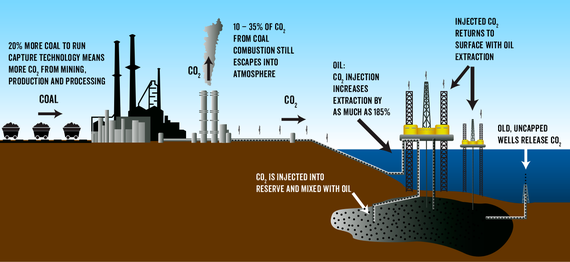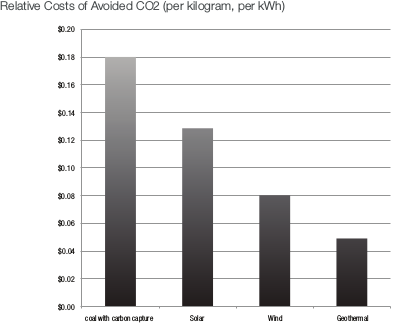Greenpeace USA just released “Carbon Capture Scam (CCS): How a False Climate Solution Bolsters Big Oil,” a report explaining why support for carbon capture and sequestration (CCS) must stop. Cynics of the potential of renewable energy have advocated for CCS as a way to keep coal plants running without harming the climate, by capturing the carbon pollution and storing it underground forever. To the contrary, carbon capture is just replacing smokestacks with a Rube Goldberg machine that’s even worse for the climate. The CO2 from burning coal ultimately still gets into the atmosphere, but expensive, subsidized equipment first takes the CO2 on a long, inefficient detour.
CCS Is Part of the ‘All of the Above’ Strategy to Push Fossil Fuels: Tragically, the CO2 collected from coal plants will become a catalyst for even more CO2 pollution. Captured CO2 will be piped directly to oil rigs. The oil rigs pump the CO2 into reservoirs so the oil expands and is forced up the well. The main driver behind carbon capture development is maintaining our dependence on fossil fuels.
EPA’s proposed carbon rule requires that new coal plants capture CO2, and emphasizes the CO2 be used to augment oil extraction. Every major power plant CCS project in the United States intends to sell the scrubbed CO2 to the oil extraction industry.
Some claim that oil produced with CO2 injection is going to get produced somewhere else anyway, and therefore would actually be ‘green’ oil because it keeps CO2 from a coal plant from entering the atmosphere. Is this really clean coal for green oil? It sounds confusing because it is nonsense for many reasons, one being that injected CO2 comes back up the well with the oil.
However, this reflects the Obama Administration view that fossil fuel supply has no bearing whatsoever on fossil fuel use. The Administration’s ‘All of the Above’ energy strategy is steeped in this false logic. The Obama administration effectively argues that no fossil fuel supply project in the United States ever has any impact on the climate. This either manic or myopic mindset is communicated by every federal agency making decisions about fossil fuel supply projects. For example:
- The US State Department environmental impact analysis in 2013 (which may be rejected) concluded the KXL pipeline won’t contribute additional carbon pollution – because it means other oil transport methods won’t be used.
- The Bureau of Land Management auctions off taxpayer-owned coal and discounts any CO2 created by burning that coal – because it means coal in some other part of the world won’t get mined.
- The Bureau of Ocean Energy Management claims there is no additional CO2 from burning oil extracted in the Arctic – because Arctic oil will simply displace oil on the international market.
- EPA’s proposed carbon rule for future power sources promotes expanding oil production and regards emissions from burning that additional oil as irrelevant.
CO2 injection is just one more way for the industry to expand, along with drilling in the Arctic Ocean, hydraulic fracturing, and tar sands production. The oil industry has used CO2 to augment oil production since the 1980s, and has been using it more and more ever since. Demand for CO2 in oil production exceeded supply around 2004. Using CO2 capture for oil extraction may actually precede any serious attempts to develop CCS for the climate.
Oil produced from CO2 injection arguably is worse than conventional oil since it comes with CO2 emissions from coal extraction, processing, new coal combustion (not all the CO2 is captured), and combustion of oil that would otherwise stay in the ground. One analysis claims that up to 185% more oil per well can be extracted using CO2 injection.
We Don’t Have the Time or Money to Waste on CCS: Even assuming that CO2 sequestration underground could work in theory, the technology cannot be developed and scaled up in time to help avoid the worst impacts of climate change. The most ardent purveyors of CCS, including the International Energy Agency (IEA), agree on this losing timeline. Why should we waste time and money scrambling to develop a technology that may not even work, particularly when it is being developed to promote oil supply and keep us hooked on fossil fuels? We know renewables work and that they can help solve our climate crisis now.
If it could work scientifically and politically, according to cost estimates from its proponents, CCS still would be the most expensive method for avoiding future CO2 pollution from electricity production. This is based on cost projections from the US Energy Information Administration (EIA) for new sources of electricity in 2019. While EIA, part of of the US Department of Energy (DOE), has been sympathetic to CCS in its analysis, its own projections argue against CCS investment. DOE is doling out billions of dollars to CCS projects that use the CO2 to expand oil supply and cost far more than its own analysis about cost and strategies for scaling up overall investment in CCS.
In our report we calculate the cost of avoiding 1 kilogram of CO2 per 1 kilowatt hour of electricity generated by a new source. We start with EIA estimates about the costs of new power sources coming on line in four years. We use generous estimates about CCS cost and efficiency, and are also generous to coal when it comes to greenhouse gas emissions upstream (e.g., mining, processing, transportation). We are cynical about factors of renewables such as solar energy storage. Even being so unduly fair to CCS, per unit of electricity it would still cost almost 40% more per kilogram of avoided CO2 compared with solar photovoltaic, 125% more than wind, and 260% more than geothermal.
Sequestering CO2 Underground Is a Shaky Notion Anyway: Permanent sequestration is elusive even if it were the goal. One problem is that fracking and shale gas reserves are located in the same places with the greatest potential for CO2 sequestration. Fracking causes earthquakes. The In Salah project in Algeria, one of the few large scale CCS projects in the world, shut down indefinitely in 2011 because the CO2 injection itself caused seismic activity that cracked the cap rock.
CO2 injection can also lead to so-called ‘downhole communication’ (or ‘frack hits’), where what is injected in one hole just comes out another. It doesn’t help that there are already about 12 million oil and gas wells in the USA, up to 3 million of which are abandoned, uncapped, and unmonitored.
Even without complicating factors due to fracking, the sheer number of wells, instigation of earthquakes, or industry negligence, the science of sequestering CO2 underground permanently is also dubious. A recent MIT study found that the majority of CO2 injected into saline aquifers, a type of geology believed to have great sequestration potential, could uncontrollably make its way back to the surface. The IEA has proposed depleted oil reserves as the other main category of geology with the greatest potential for long term CO2 sequestration. Beyond having little evidence it will work, this is precisely what the oil industry wants for expanding oil production.
Real Climate Leaders Support Fossil Fuel Phase-out: CCS will actually increase the overall environmental impact of fossil fuels, in part because running carbon capture equipment requires burning around 20% more fuel. That means more mining, more coal trains, more coal ash, among a sordid suite of stages in the fossil fuel life cycle that plague public health and the economy.
It is not possible to support the use of fossil fuels and the climate simultaneously. True climate leaders have no option but to tackle head-on the damaging economic entrenchment of the coal, oil, and gas industry.
EPA should rethink its proposed rule and come up with a final policy that acknowledges investment in fossil fuel-fired power plants, and fossil extraction must come to an end. Renewable energy is the future. This is also why the Obama administration should support a goal of 100% renewables by 2050 in the Paris climate treaty to be decided at the end of the year.


